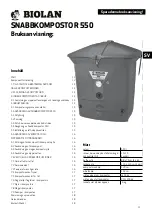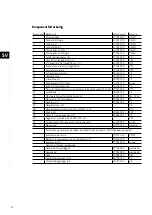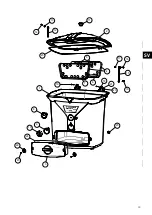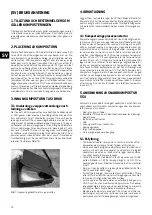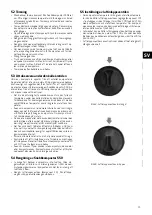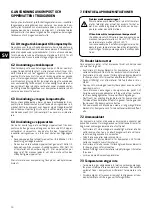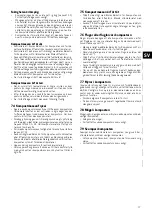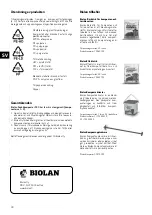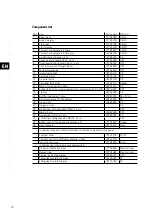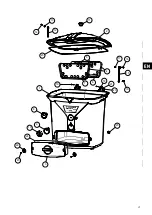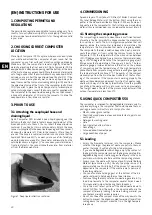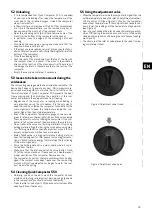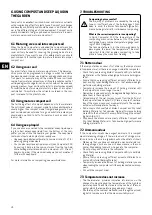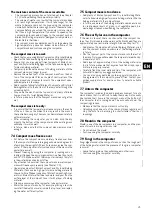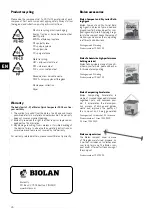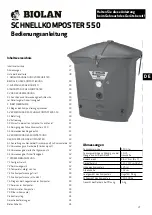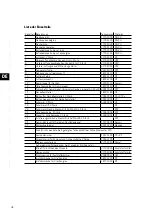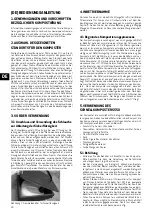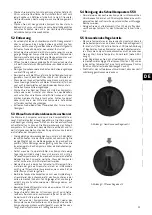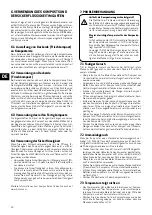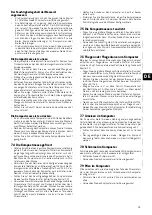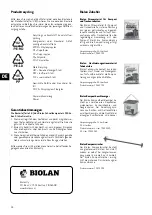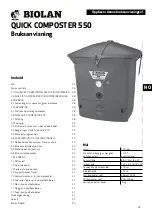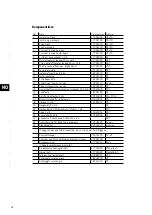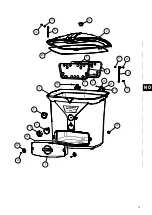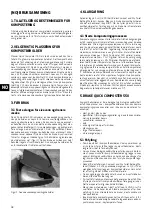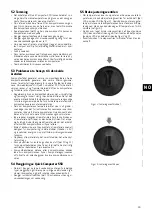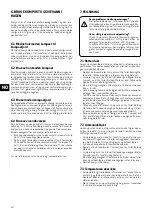
25
FI
SV
EN
DE
NO
ET
LV
LT
RU
FR
PL
CS
The moisture content of the mass is suitable:
•
The composting process has not started yet (see Chapter
4.1). Continue loading the composter normally.
•
The volume of waste is so low that the compost mass does
not reach high temperatures. It will take longer for the
waste to become compost. Continue using the composter
normally. Whether there is enough time for the waste to de-
compose before you unload the composter is more impor-
tant than a high temperature. If you want to speed up the
composting process, add nitrogen to the compost, such as
Biolan Composting accelerator, designed for composters, or
Biolan Natural Fertiliser.
•
The compost mass has decomposed to a stage where the
high-temperature phase has ended. Unload some of the
compost mass and continue using the composter.
The compost mass is too wet:
• Check that you are using Biolan Compost and Dry toilet Bulking
Agent or the Tehokuivike high-performance bulking material.
• Ensure that you are using sufficient amounts of Biolan Com-
post and Dry toilet Bulking Agent or the Tehokuivike high-per-
formance bulking material.
• Temporarily increase the amount of bulking material until the
compost mass is no longer too wet.
• Remove the wettest part of the compost mass from the bot-
tom of the composter. Place a couple of centimetres of the
mass around your ornamental plants. The unpleasant odour
will dissipate in a few days.
• Add a couple of shovelfuls of Biolan of Compost and Dry toilet
Bulking Material to the bottom of the composter through the
unloading hatch.
• Drop down the mass from the top and stir in plenty of Biolan
Compost and Dry toilet Bulking Material.
• In future, make sure that the compost mass does not get too
wet.
The compost mass is too dry:
• It is normal that the temperature increases more in the centre
of the unit than on the sides. This may result in the mass in
the centre becoming dry. The mass can be moistened carefully
with warm water.
• After unloading the composter, you can also drop the dry
mass to the bottom of the composter and the existing mass
will make it moist as well.
• In future, make sure that the compost mass remains moist
enough.
7.4 Compost mass freezes over
• Act before the compost mass completely freezes over. Even
if the composter’s temperature gauge shows zero degrees for
a few days, there might still be unfrozen mass inside the com-
poster. If the composter is full, unload some of the mass in the
wintertime as well.
• Prevent freezing by using the composter (= loading and un-
loading it) to keep the micro-organisms active. See Chapters 5
and 5.1–5.5. Make sure that the composter is always fairly full
in the wintertime and unload it often.
• Pay attention to how moist the compost mass is: wet compost
mass will freeze up more easily (see Chapter 7.3).
• Use ample amounts of Biolan Compost and Dry toilet Bulking
Material or Tehokuivike high-performance bulking material in
the wintertime. Make a loose mix of Biolan Composting Accel-
erator or Biolan Natural Fertiliser and water and pour it on the
surface layer of the compost. Cover it with a layer of bulking
material.
• Pile some snow around the composter to keep it warmer.
• Warm the compost mass by, for example, placing a ten-litre
canister filled with hot water inside the top layer and replac-
ing the water sufficiently often.
7.5 Compost mass is too dense
• Add plenty of Biolan Compost and Dry toilet Bulking Mate-
rial or Tehokuivike high-performance bulking material. Mix the
bulking material into the compost mass.
• In future, use more of the bulking material and make sure not
to create dense layers of grass, root vegetable peels, bio-
waste bags or leaves when loading the composter.
7.6 Flies or fly larvae in the composter
If the mass is too wet, there is a chance that the compost con-
tains flies. Fly larvae are white worms with a black head. They are
approximately one centimetre in length. Also see Chapter 7.3.
• Add plenty of Compost and Dry toilet Bulking Material, mix it
into the compost mass and use more of the bulking material
in future.
• Mix the topmost part of the compost mass into the rest of
the mass. Fly larvae will die when the temperature reaches ap-
proxi43°C.
• Add a layer of approximately 2 cm of the bulking material on
top. In future, make sure that any meat and fish scraps, in par-
ticular, are properly covered.
• Carefully flush the inner walls and lid of the composter with
hot water to destroy any eggs and larvae.
• You can also spray pesticide containing pyrethrin as the ac-
tive ingredient in the compost to prevent flies. Contact your
garden supply store for advice on how to select a suitable
product.
7.7 Ants in the composter
The composter includes food and a good environment for ants,
which means that it is difficult to keep them away. Ants usually
like to make their home in the compost mass at the bottom of
the composter that is cooling down. The ants will not harm the
composting process.
• Make sure that the compost mass is not too dry.
• Unloading small amounts of the compost mass regularly will
stop the ants from becoming too comfortable in their sur-
roundings.
7.8 Mould in the composter
Mould is one of the decomposers in a composter, and the pres-
ence of mould in a composter is normal.
• Do not remove the mould.
• Continue using the composter normally.
7.9 Fungi in the composter
Fungi digest wood in the compost mass, such as the rough part
of the bulking material, and the presence of fungi in a composter
is normal.
• Leave the fungi alone: they will disappear on their own.
• Continue using the composter normally.

